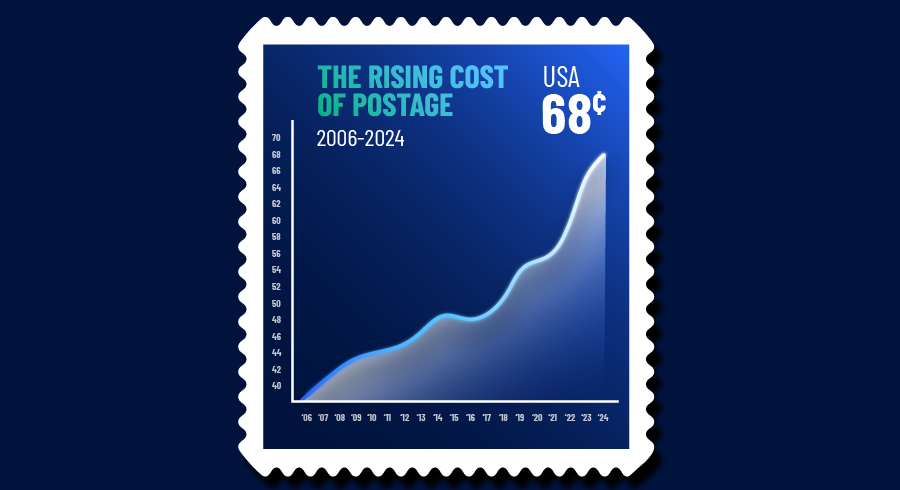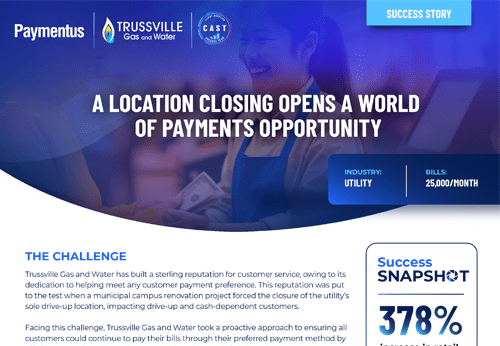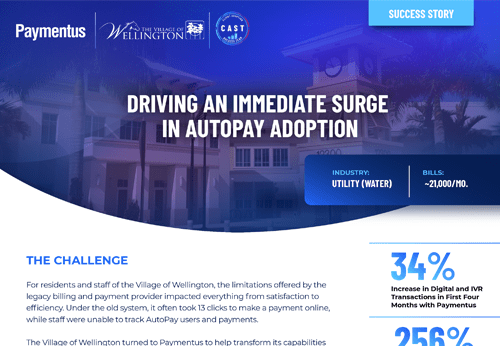Simple Steps to Combat Rising Postage Costs
If it feels like you're mailing away an increasing percentage of your revenue each month, it’s likely that you are. After recent discussions with clients, the Paymentus Client Adoption Success Team (CAST) wanted to share a major pain point impacting many billers: the escalating cost of postage.
Postage price hikes are occurring more frequently in today’s economy, showing no signs of slowing down. As of January 2024, United States postage reached a record high of $0.68 per stamp. That is a 20% increase in the cost to mail a letter over the past year.
Imagine giving your clients a 20% increase in costs year over year (or even in three years). They would revolt! This increase follows two hikes in 2023, with postage increasing 10-cents since August 2021. For billers still responsible for mailing out hundreds or even thousands of bills, the rising costs of postage accumulate quickly.

The encouraging news is that there are digital payment options billers can embrace to save on rising postage costs and also deliver a modern customer experience. Let's explore a few digital payment capabilities and methods embraced by both billers and customers that solve the challenge presented by rising postage.
Paperless eBilling & Turning Print Off
Paperless eBilling and a reduction in printed bills is the most direct solution to combat rising postage expenses. eBilling, where customers receive a notification and access to a digital version of their bill in lieu of a paper bill, is a faster and more cost-effective billing option than traditional paper bills. The added benefit of paperless eBilling is that it often drives higher digital payment adoption rates by introducing customers to a digital-first experience. With multiple communication avenues including mobile app, browser, text and email options, eBilling can meet the preference of any customer.
An additional benefit of eBilling for billers is the ability to send proactive payment notifications directly to customers’ mobile and electronic devices – removing the need for paper completely. This also delivers the bill in the channels that meet the customer where they want to be and in their device of choice. This ensures customers won't overlook bills or miss payments, a feature lacking in traditional paper billing.
The financial benefits of eBilling extend beyond customer satisfaction – your bottom line will see the effects as much as your customers do. A Paymentus mortgage client reported that since 2016, over 55,000 accounts have transitioned to paperless billing, resulting in approximately $343K in annual savings on postage and printing expenses alone. That was in 2016, when postage was just $0.40 – imagine the continued savings in today's landscape as postage prices continue to rise.
AutoPay & Recurring Payments
AutoPay is a service that allows customers to automatically have their payments deducted each month using their specified payment method. AutoPay allows customers to schedule recurring payments, choose fixed or variable amounts, and use various payment methods including credit, debit, digital wallets (PayPal, PayPal Credit, Venmo, Google Pay, Apple Pay and Amazon Pay) and traditional checking or savings accounts (ACH/eCheck).
Regardless of their inclination for digital payment methods, many customers prefer AutoPay due to its ability to relieve the stress of managing and monitoring monthly bill payments. With the average bill payer paying nearly 17 bills per month, the desire for automated payments is on the rise. AutoPay adds a layer of convenience not offered by any other payment option, while also giving organizations the ability to leverage integrated digital notifications for both pre- and post-payment alerts. This capability ensures timely payments and has proven to reduce delinquencies by up to 50%.
For Alfa Insurance, its 43% year-over-year increase in AutoPay adoption was accompanied by a 22% increase in paperless billing. Through this, Alfa was able to save an estimated $3.00 per bill, netting an annual savings exceeding $1 million annually.
Pay-by-Text & Pay-by-Email
Pay-by-Text and Pay-by-Email offer a superior level of customer convenience by taking advantage of today’s most popular communication methods.
With Pay-by-Text, customers receive their current balance and due date via text message. With a one-word text response, they can instantly pay their bill using the payment information stored within their customer account.
Pay-by-Email allows billers to forgo traditional mail by sending bills directly to customer inboxes. A unique aspect of Pay-by-Email is that it is designed to be mobile-friendly. Billers can offer customers two types of bills to accommodate the vast majority of people accessing email through their phone:
Traditional bill-ready email, which features a link back to the biller website
“Smart PDF” eBill, which is password-protected and allows the customer to pay the bill within the PDF itself
These options offer a straight line to your customers’ most widely used communication channels that adds no extra costs to your organization.
Driving Digital Adoption to Save Postage Costs
Marketing is a crucial – and sometimes overlooked – aspect of driving digital payment adoption. Whether your organization is introducing a new digital payment option or is looking to drive the adoption of existing offerings, it's essential to establish a strategy aimed at boosting customer adoption of these solutions.
The main key to a successful campaign is to deploy marketing through several channels. In particular, if looking to convert paper customers, focusing on bill inserts, postcards, emails and social channels gives you a chance to meet your customers where they currently are and where you’d like them to be. It’s also important to highlight the benefits of these paperless options. While the benefit to the biller is obvious from a revenue perspective, customers will be motivated by different factors. Convenience, speed and security are three main benefits we encourage billers to focus on, though there are many more from which to choose.
Lastly, for customers hesitant to adopt digital payments, addressing concerns through a dedicated FAQ page can offer reassurance. This can also serve as a way to provide clear instruction on how customers can sign up for or use various offerings, with the added bonus of providing peace of mind.
It's important to acknowledge that some customers still prefer receiving bills by mail, and their concerns should be understood and addressed accordingly. But with the cost of postage continuing to grow with no signs of slowing, billers must maximize the many billing and payment capabilities available today.
Paymentus goes beyond billing and payments to help you maximize your billing and payment investment. The holistic Paymentus solution offers end-to-end capabilities to reduce your cost to serve including bill print and statement services, eBills, notifications, paper suppression and more. Contact us today to see what you can save. You can also request marketing help by emailing CAST@paymentus.com to learn more about this complimentary program and how it can help meet your needs.



